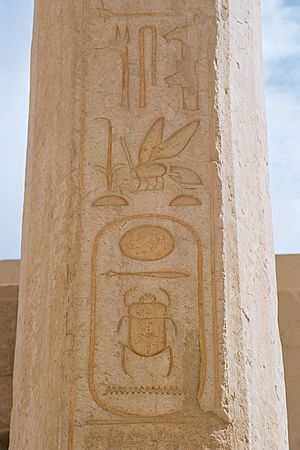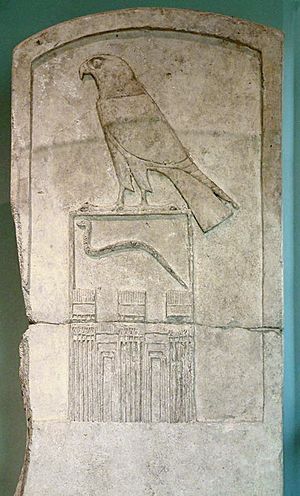Ancient Egyptian royal titles facts for kids
The Ancient Egyptian royal titles were special names given to the pharaohs, who were the kings of Ancient Egypt. These names and titles showed how powerful the king was, both in ruling the land and in religious matters. The names could also act like a goal or promise for the king's rule. Sometimes, a pharaoh's names and titles would even change while they were still king.
By the time of the Middle Kingdom, pharaohs used a set of five main titles. This full set of five names became the standard way to name a pharaoh. They were still used much later, even during the Roman Empire.
Contents
Horus Name
|
|
The Horus name is the oldest type of name a pharaoh had. It started way back in the Predynastic Period, before Egypt was fully united. Many of the earliest Egyptian pharaohs are only known by this title.
The Horus name was usually written inside a special symbol called a serekh. This symbol looked like the front of a royal palace. The pharaoh's name was written in hieroglyphs inside the serekh. Usually, there was a picture of the falcon god Horus placed on top or next to it.
One Egyptian ruler, Seth-Peribsen from the 2nd dynasty, used a picture of the god Seth instead of Horus. This might mean there was a religious disagreement in the country at that time. The next king, Khasekhemwy, put symbols of both Seth and Horus above his name. After him, later kings always used the image of Horus with their name.
By the time of the New Kingdom, the Horus name was often written without the serekh around it.
Nebty ("Two Ladies") Name
|
|
The Nebty name means "two ladies." This title was connected to two important goddesses who protected Upper and Lower Egypt:
- Nekhbet, the goddess of Upper Egypt, shown as a vulture.
- Wadjet, the goddess of Lower Egypt, shown as a cobra.
The pharaoh Semerkhet from the First Dynasty was the first to definitely use this name. It became a separate and important title by the Twelfth Dynasty.
The Nebty name was not usually put inside a cartouche or a serekh. It always starts with the hieroglyphs of a vulture and a cobra. These two symbols rest on top of two baskets, which represent the word "nebty."
Horus of Gold Name
|
|
This title is also known as the Golden Horus Name. In this name, the pharaoh's name was shown with a Horus falcon. The falcon was either perched above or next to the hieroglyph for gold.
The exact meaning of this title has been debated by experts. It might show that Horus was victorious over his uncle Seth. The symbol for gold could mean that Horus was "better than his enemies." Gold was also linked to ideas of eternity and lasting forever. So, the name might show that the pharaoh's Horus name would last forever.
Like the Nebty name, this name was not placed inside a cartouche or a serekh.
Throne Name (Prenomen)

|
|
The pharaoh's throne name was the first of two names written inside a cartouche. It came with the title nsw-bity. This title means "S/He of the Sedge and Bee." This is often translated as "King of Upper and of Lower Egypt." This is because the sedge plant and the bee were symbols for Upper and Lower Egypt.
The term nsw-bity might have come from an old Berber word meaning "strong man" or "ruler."
Another title often used with this name was neb tawy. This means "Lord of the Two Lands." It refers to the two main regions of Egypt: the Nile Valley (Upper Egypt) and the Nile Delta (Lower Egypt).
Personal Name (Nomen)
|
This was the name given to the pharaoh when they were born. The name itself was introduced by the title "Son of Ra." This was written with the hieroglyph of a duck (za). This duck symbol sounded like the word for "son" (za). Next to it was an image of the sun, which was the hieroglyph for the god Ra. This title was first added to the royal names in the Fourth Dynasty. It showed that the king was a representative of the sun god Ra. If the pharaoh was a woman, the title was understood as "daughter."
Today, historians usually use this birth name when talking about ancient Egyptian kings. They often add numbers like "II" or "III" to tell apart different pharaohs who had the same name.
Examples of the Full Titulary
Senusret I
In the Middle Kingdom, the full set of five titles was sometimes written together in one cartouche. This example is from Senusret I, found in Beni Hasan.
Hatshepsut
The full set of titles for Hatshepsut, a pharaoh from the Eighteenth Dynasty. This shows how the titles were different when the pharaoh was a woman:
- Praenomen (Throne Name): Maatkare, meaning "Truth [Ma'at] is the Ka of Re."
- Nomen (Personal Name): Khnumt-Amun Hatshepsut, meaning "Joined with Amun, Foremost of Noble Ladies."
- Horus name: Wesretkau, meaning "Mighty of Kas."
- Nebty name: Wadjrenput, meaning "She of the Two Ladies, Flourishing of years."
- Golden Horus: Netjeretkhau, meaning "Divine of appearance." (Netjeret is the feminine form of netery, meaning 'godly' or 'divine', and khau means 'appearances').
Thutmose III
The full set of titles for Thutmose III, a pharaoh from the Eighteenth Dynasty. Here are their meanings:
- Horus name: Kanakht Khaemwaset, meaning "Horus Mighty Bull, Arising in Thebes."
- Nebty name: Wahnesytmireempet, meaning "He of the Two Ladies, Enduring in kingship like Re in heaven."
- Golden Horus: Sekhempahtydjeserkhaw, meaning "Horus of Gold Powerful of strength, Sacred of appearance."
- Praenomen (Throne Name): Menkheperre, meaning "He of the Sedge and the Bee, Enduring of form is Re."
- Nomen (Personal Name): Thutmose Neferkheperu, meaning "Son of Ra, Thutmose, beautiful of forms."
See Also



